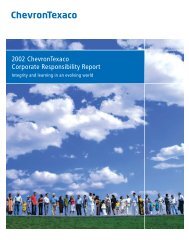-i- TO THE SUBROGATE PRESIDENT OF THE ... - Chevron
-i- TO THE SUBROGATE PRESIDENT OF THE ... - Chevron
-i- TO THE SUBROGATE PRESIDENT OF THE ... - Chevron
You also want an ePaper? Increase the reach of your titles
YUMPU automatically turns print PDFs into web optimized ePapers that Google loves.
plaintiffs have not alleged, and have not proven, the existence of any individualized<br />
harm to any particular individual or legally cognizable entity. The complaint alleges<br />
harm to “communities” that the plaintiffs purport to represent, but these communities are<br />
only vaguely defined. There is, furthermore, no proof that the plaintiffs have been duly<br />
authorized to represent them with respect to any claims for divisible injuries. 763 In all<br />
events, although Chapter III of the complaint 764 contains general and imprecise<br />
allegations of environmental effects, in the operative part of the complaint (Chapter VI)<br />
the plaintiffs do not request damages for specific injuries—either to individuals or to the<br />
vaguely defined communities. 765 Thus, their request for damages cannot be premised<br />
on any relevant provision of the Civil Code; it necessarily is premised on the 1999 EMA<br />
instead.<br />
The absence of any basis in the Civil Code for the plaintiffs’ damages claim is<br />
further confirmed by the fact that any such claim under the Civil Code plainly is time<br />
barred. 766 The concept of a statute of limitations has been defined legally as the<br />
“manner of extinguishing a right as a result of failure to exercise such right during the<br />
time period established by law.” 767 Section 1583(11) of the Civil Code generally refers<br />
to the statute of limitations as a means of extinguishing obligations, whereas Section<br />
2392 of the Civil Code refers to it as means of extinguishing “causes of action.” As<br />
Ecuador’s former Supreme Court (now the National Court) has stated: “The defense of<br />
the statute of limitations is a way to extinguish the substantive aspects of a cause of<br />
action, and if it is found to apply, then the Judge cannot rule on the claims set forth in<br />
763 It is unclear from the complaint and the evidence who is included in the supposed 30,000<br />
persons that the plaintiffs purport to represent. Their identities and addresses are unknown, so it is<br />
impossible to know whether they belong to the communities that the plaintiffs say they represent, whether<br />
they are located within or outside of the former concession area, and whether they were affected by the<br />
oil operations.<br />
764 Plaintiffs’ Complaint, filed May 7, 2003 at 11:30 a.m., Record at 73-80v, 76-77.<br />
765 See Plaintiffs’ Complaint, filed May 7, 2007 at 11:30 a.m., Record at 73-80v, 79-80. This case<br />
therefore contrasts with Delfina Torres case, Comité Delfina Torres Vda. de Concha vs. Petroecuador y<br />
otros, Judgment of the Supreme Court of Justice, First Civil and Commercial Division, Oct. 29, 2002,<br />
Case 229, published in Official Gazette 43, Mar. 19, 2003, where the named plaintiff—proceeding under<br />
the Civil Code (Article 2214) in an ordinary proceeding—appeared in “the capacity of legal representative<br />
of a private law legal entity” to redress the direct injuries to that entity that were pleaded and proved with<br />
particularity and specificity. (Nos. 5, 15 and 27) Indeed, the Supreme Court expressly noted that “[i]f the<br />
action had been brought as a legal representative of the ‘public interest’ or of society in general,<br />
doubtless this would have been procedurally barred, or there would be no standing to sue according to<br />
the terminology adopted by our Code of Civil Procedure.” (No. 5)<br />
766 This defense was expressly raised by my client when it answered the complaint, based on<br />
Section 2259 (currently 2235) of the Civil Code. See Answer as Read into the Record § IV.3.4, filed Oct.<br />
21, 2003 at 9:10 a.m., Record at 243-67, 265. The assertion of the defense cannot be interpreted as a<br />
recognition that the plaintiffs have a cause of action of any kind. The statute of limitations would bar the<br />
alleged causes of action if they existed, which they do not.<br />
767 Dictionary of the Spanish Language, Royal Spanish Academy, Madrid, Spain (22nd ed. 2001).<br />
CERT. INTERMARK VER: JD<br />
- 171 -

















